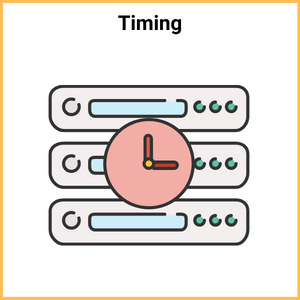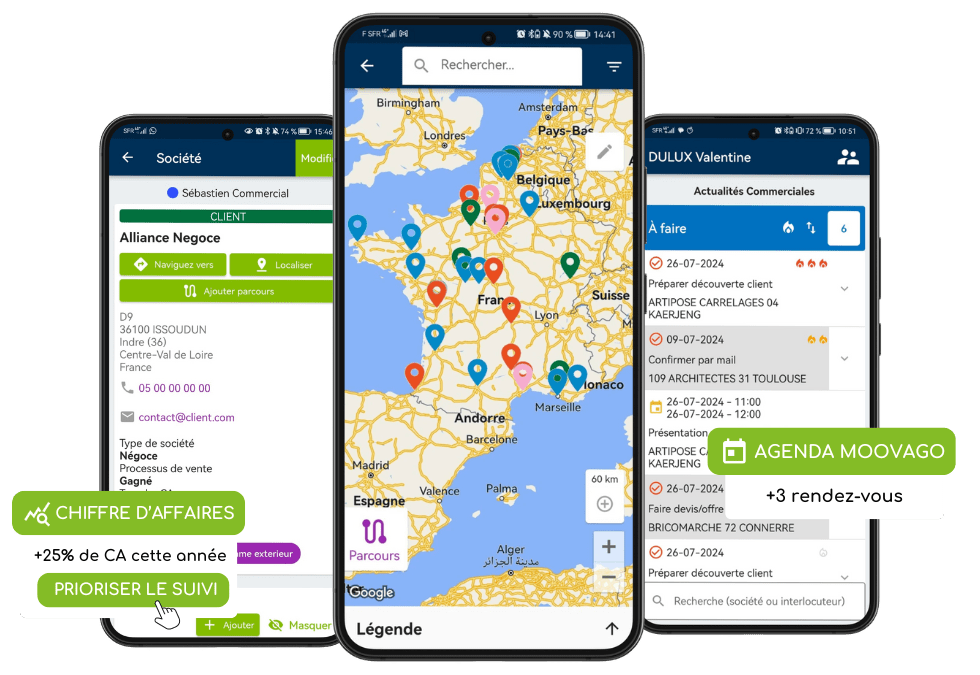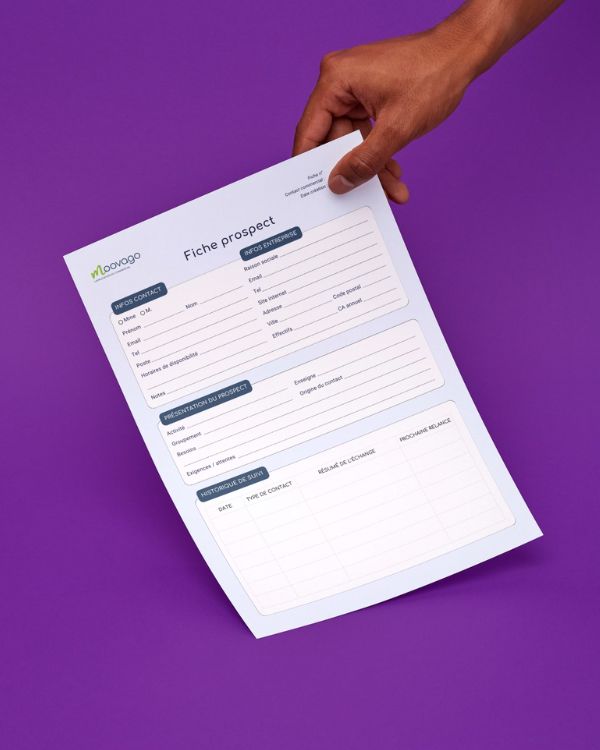Telephone prospecting may be perceived as an outdated sales technique, but did you know that 69% of buyers are still open to being contacted by telephone?
If you want to increase your sales and improve your sales approach, it may be time to invest in this prospecting method and improve your current processes.
In this article, discover a 6-step method to turn your cold calls into real sales opportunities, whether you’re a beginner or an experienced salesperson.
What is cold calling and why is it still effective in 2025?
Definition and fundamental principles
Cold calling is the process of contacting potential customers by telephone who have not expressed interest in your product or service. It’s a proactive approach that allows you to go directly to your prospects, rather than waiting for them to come to you.

An essential fact to remember: 100% of customers and prospects use the telephone at some point in their purchasing journey. Despite the emergence of digital channels, voice communication remains central to the sales process.
What are the advantages of telephone prospecting?
Telephone prospecting has many advantages for your organization. Among the most important are the following:
- It lets you reach a wide audience quickly and easily.
- It is relatively inexpensive compared to other techniques.
- It’s a direct way to sell your product or service, without interference from competing brands.
- It allows you to gauge customer interest quickly and easily.
- It can be used to generate lukewarm leads for appointments or customer visits in the field.
What are the challenges and drawbacks of telephone prospecting?
- It can be difficult to reach a company’s decision-makers. You may have to go through several levels of control before you reach the decision-makers.
- You may encounter resistance from potential customers who aren’t interested in what you have to say.
- This can be very time-consuming, as you’ll need to make a large number of calls to generate a decent number of leads. On average, it takes 18 calls to make contact with a potential buyer.
Step 1: Define your target audience for more relevant calls
Before you even pick up the phone, the first step is to identify exactly who you’re going to call. This preparatory phase is often overlooked, even though it’s crucial to your conversion rate! For more information, take a look at this guide from LaGrowthMachine.
Segmentation techniques and prior qualification
To maximize your chances of success, start by clearly defining your ideal customer. A well-targeted call will always be more effective than a dozen blind calls. To establish this profile, consider :
- Company demographics (size, sector, location),
- Decision-maker profile (function, hierarchical level, decision-making power),
- The specific needs your solution can meet,
- The potential budget available for your offer,
- History of relations with your company.
Did you know that 75% of successful salespeople research their prospects before they call? This preparation is not a waste of time, but an investment that significantly increases your chances of conversion.

Sources and tools for building a base of qualified prospects
The quality of your prospect base largely determines the success of your telephone prospecting. There are several complementary sources you can use to enrich your database. Sector-specific databases are an excellent starting point, as they offer contacts already pre-qualified according to precise criteria. In parallel, LinkedIn has established itself as the essential network for identifying decision-makers, thanks to its advanced filters and wealth of professional profiles.
Industry events also represent a valuable opportunity, with prospects already interested in your field of activity. And don’t forget that your satisfied customers can become your best ambassadors – their recommendations are often the most qualified and receptive source.
The key is to focus on the quality of your contacts rather than their quantity, an approach that will significantly maximize your conversion rate.
Resource : how to develop your customer database?
MODEL PROSPECT SHEET:
Qualify your contacts during or after your telephone prospecting campaign
Boost your telephone sales with our FREE ready-to-fill prospect form.
Keep a careful record of your prospects’ information, detail and analyze their needs, and follow up your exchanges more effectively!
Keep in mind that this preparatory phase needs to be integrated into your CRM to capitalize on the information gathered. With Moovago, you can easily centralize all this data and have it at hand during your calls, for smoother, more efficient prospecting.
Step 2: Prepare an effective, customizable call script
Depending on your business, a good idea is to create scripts to help your sales reps make cold calls. However, writing a good cold calling script is a difficult exercise. Too rigid, and you’ll get stuck. Too broad, and you won’t convince anyone.

Structure of a winning telephone prospecting script
An effective script functions as a flexible guide, not as a text to be recited. Incorporate these six key elements: a clear introduction, a personalized hook linked to the target company, a concise value proposition, 3-5 strategic qualifying questions, prepared answers to common objections, and a precise call-to-action for what comes next.
Your script needs to be concise while covering these essential points, bearing in mind that it generally takes 5-10 minutes to convince a prospect over the phone (according to Decidento).
📚 Example of a telephone prospecting script :
“Hello, I’m [your name] from Moovago. We help field sales representatives optimize their organization and save 2 to 3 hours a week. I’m contacting you because I’ve noticed that your company has a traveling sales team and I was wondering how you currently manage the organization of your rounds and customer follow-up? [Pause for reply]
That’s interesting… And what are your main challenges in this area? [Pause for response]
I understand. We’ve developed a solution that does just that [specific benefit related to the problem mentioned]. Would you be available for a short meeting where I could show you how it works in concrete terms?”
Attention-grabbing hook techniques
There’s certainly one burning question left, now that your script is ready. How do you get a customer’s attention over the phone?
Avoid overly generic formulations such as “How are you today?” or “Do you have a few minutes?”.
Here are a few proven strategies for capturing your contact person’s attention:
- Refer to a relevant news item: “I’m calling you following the announcement of your promotion to…”.
- Mention a recommendation: “Your colleague Mr Dupont suggested I contact you…”.
- Ask a strategic question (or one he won’t be able to say no to): “Are you currently looking to (need you’re meeting)?” / “Would you be interested in saving up to 1 hour a day on (thankless daily tasks)?” / “Would you like to save money on… ?”
- Share a powerful statistic Did you know that salespeople waste an average of 4 hours a week on administrative tasks?
Handling objections
- “I don’t have time”: “I understand. Could we agree on a more convenient time in your diary?”
- “We’re already working with a supplier”: “Great, that shows you see the value in this type of solution. Would you be open to discovering the aspects where we differentiate ourselves?”
- “It’s too expensive”: “I understand your concern. Could we first discuss your specific needs to assess the potential return on investment?”
Perseverance, accompanied by a well-prepared script, often makes all the difference between failure and success.
Step 3: Choosing the right time to make your calls

Timing is an often underestimated factor in telephone prospecting. Yet it’s important to choose a moment when the person you’re calling is likely to be available and receptive to your pitch.
Not all times of day are the same for phoning. According to a number of studies, here are the best times of day:
- Between 9 and 10 a.m.: the prospect has generally dealt with his or her urgent matters, but is not yet absorbed in meetings.
- Between 4pm and 5pm: the day ends, important decisions are made, the mind is more open.
- Tuesday, Wednesday and Thursday: these intermediate days are more favorable than Monday (too many accumulated tasks) or Friday (anticipation of the weekend).
A valuable tip: decision-makers are often more available outside secretarial hours (before 9am, after 6pm, or during lunch breaks). These “off-peak” times sometimes allow you to bypass the usual filters and get direct access to the person you’re looking for.
Timing isn’t just about time of day, it’s also about responsiveness to signals of interest. Did you know that prospects are 100 times more likely to respond if you call them within 5 minutes of a web request? This “golden window” is crucial to capitalizing on the interest of the moment.
Step 4: Use the right tools to optimize your approach

To facilitate cold calling, it’s important to have the right tools. There are many software programs available that can automate and track your calls. This can be very useful, especially if you make a large number of calls. Here are some of the features you should look for in a cold calling tool:
- The ability to leave automatic messages,
- A call recording function,
- A caller ID function,
- The ability to create and manage call lists,
- The ability to schedule calls,
- CRM integration/connection.
What are the main telephone prospecting tools?
There are several telephone prospecting tools on the market. The best-known are the following:
- SoClosed: this tool offers a wide range of functions, such as call recording, automatic call distribution, call analysis and more. It can also be integrated with your CRM.
- Aircall: this is another all-in-one telephony solution offering a host of features such as call recording, number masking, automatic call distribution and integration with over 150 business applications.
- Zoom Info : This tool is mainly used for business intelligence. It enables you to obtain information about your prospects, such as their e-mail addresses, telephone numbers or social media profiles.
In fact, most of these solutions offer 7 or 14-day free trial periods, giving you the opportunity to try out the tool for yourself.
The central role of CRM in your phoning strategy
A CRM (Customer Relationship Management) is the cornerstone of effective telephone prospecting. It enables you to :
- Centralize all information on your prospects: contact details, interaction history, call notes, etc.
- Segment your database: to target the most relevant prospects for priority calling
- Schedule automatic reminders: never forget to contact a promising prospect again
- Track your performance: contact rate, conversion rate, average time per call
For traveling sales representatives who alternate between telephone and field prospecting, a CRM like Moovago offers the considerable advantage of having been designed FOR their activity (and only for it). It’s a very simple tool, which allows you to efficiently organize your customer follow-up and your daily tasks before and after your calls, as well as organizing your rounds.

Step 5: Mastering telephone sales techniques
To transform your calls into concrete sales opportunities, mastery of telephone sales techniques is essential. Beyond the tools, it’s your ability to convince that will make the difference.
The right attitude
Telephone selling requires specific skills to compensate for the absence of body language. Your voice becomes your main persuasive asset: consciously vary rhythm, tone and volume to maintain attention and convey conviction and expertise.
Also learn to master silence, often wrongly perceived as failure. After an important question or a value proposition, dare to pause to give your contact person time to think and, often, to commit further.
Don’t forget that when you’re on the phone, your energy is perfectly perceptible – a smile can be heard, even from a distance! That’s why some salespeople keep a mirror next to their phone to maintain that positive attitude.
Closing strategies for different situations
Contrary to popular belief, the aim of a prospecting call is generally not to sell your product directly, but rather to obtain a commitment for the next step. It‘s better to sell the appointment rather than the product during the call.
Here are some effective closing techniques for different situations:
- The alternative proposal: “Would you prefer an appointment on Tuesday morning or Thursday afternoon?”
- The positive hypothesis: “When we meet, would you like us to also discuss…?”
- The immediate benefit: “If we arrange a meeting today, I can book you access to our exclusive webinar”.
- Social proof: “Three companies in your sector recently adopted our solution and saw their sales increase by 18%”.
Know how to recognize buying signals, such as detailed questions about operation or price, which indicate growing interest. This is the perfect time to suggest the next step!
Step 6: Measure and analyze your results
Key indicators to measure your effectiveness
Finally, it’s always important to measure and analyze the results of your cold calling campaign. This will help you to determine whether or not it is effective, and whether it deserves to be continued or improved.
- Number of calls made,
- Number of leads generated,
- The number of conversions carried out (i.e. the action/objective of your call: making an appointment, sale, demo, etc.),
- Average call duration,
- The average conversion rate.

Good to know: these KPIs must be defined in advance, before you launch your prospecting campaigns. They should remain the same for a sufficiently long period of time to assess ongoing performance and create points of comparison.
Self-assessment techniques to improve your telephone prospecting skills
Good telephone prospecting can’t be improvised, it has to be cultivated over time. As Uptoo emphasizes in its recommendations,continuous adaptation of your approach to each call is a key success factor in an ever-changing sales environment.
Start by systematically analyzing your successful calls against your failures to identify recurring patterns. What did you say differently? Which questions elicited the most positive reactions?
Controlled experimentation is also a powerful lever for progress. Modify certain elements of your script for some of your calls, then compare the results with your usual approach.
And don’t hesitate to solicit feedback directly from your converted prospects. Their unique perspective on what convinced them is often rich in unexpected insights. Complement this approach by drawing inspiration from the best: when the opportunity arises, observe the techniques employed by the most successful salespeople in your organization.
Strategies for overcoming common difficulties
Telephone prospecting comes with its share of challenges. Here’s how to turn them into opportunities:
- When faced with repeated refusals: remember that, on average, 1 sales opportunity is created after 100 calls. Every “no” brings you one step closer to a “yes”.
- To get around the roadblocks: vary your calling hours, use different approach channels in addition (email, LinkedIn).
- To stay motivated: set yourself realistic daily goals and celebrate your small victories.
Don’t forget that perseverance is the key: the salespeople who excel at cold calling are not necessarily those who receive the fewest rejections, but those who learn from each call and persist despite the obstacles.
Conclusion
For legal and respectful telephone prospecting, there are four essential rules. First, comply with the RGPD by having a valid legal basis (consent, legitimate interest or contractual relationship) before each contact. Systematically check numbers with Bloctel, as failure to comply can result in a fine of up to €75,000 for a company. Limit your calls to between 9 a.m. and 8 p.m. on weekdays, avoiding weekends and public holidays. Finally, identify yourself clearly at the start of the call, specifying the commercial purpose of your approach.
This ethical approach goes beyond mere legal compliance to reinforce your credibility and brand image in a market where trust is becoming a real competitive advantage.

